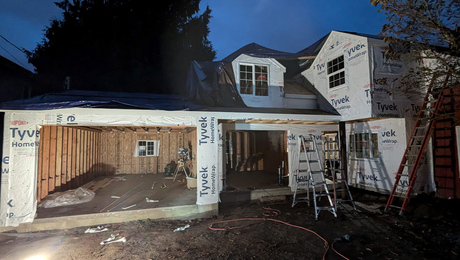Our current plumber said he adds 1/4 c (?) of olive oil to p-traps that aren’t used often or are hard to get to (under a washing machine).
The olive oil simply sits on top of the water preventing evaporation. Even if a little water goes through the drain, some of the oil remains and continues to work.
Aparently the olive oil doesn’t smell like other oils can when they get rancid.
He claims that some of his clients have p-traps so treated that still have water in them after years.
Simple. Very cool.
Just had to pass it on. When we were building big summer homes dry p-traps were a constant problem for those who would use their 7,000 sqft “cabin” for only a few weeks each year.
















Replies
P-trap? Thought they went out with copper pipe.
will heed the olive oil advice, though, with any S-traps I encounter with little use.
Carl
I assume this is a joke,but I don't see any indicator?
Nope....not a joke.
Lots of "snow birds" (northern folks that winter in Florida condos) do this when they move back and forth.
It works....EXCEPT olive oil does go rancid.
Use 1 TBPS of mineral oil.....all traps, toilets inc. 6 months later......all is well.
I was responding to hfhcarp10 about the p-traps, I guess I was not clear. His thing was that p-traps and copper pipe are passe.
Use mineral oil instead.
Never goes rancid, and is a heck of a lot cheaper.
8 dollars plus at the el-cheapo store, for two cups worth.
Probably 89 cents for the same amount of mineral oil.
Works good on top of standing water as well, to keep mosquitos out.
Yadda yadda yadda
I like the idea of mineral oil even better.
Yes mineral oil is better, I recomend it for lavs, showers, tubs, kitchen sinks, & laundry basins for vacation homes.
But floor drains & other drains that do not have a water source to dump down them on a reguler basis, trap primers are required by code, some jurisdiction do allow trapgaurds as mr Hartman linked to.Liberals thank those that beg for peace. Conservatives honor those that fought for freedoms. BDW
trap primers are required by code
In our neck of the woods I've never seen or heard of a trap primer before, in houses of any size or budget.
Does it have a float valve to keep the trap topped off?
I like the idea.
How hard would it be to use them throughout a house? Are they cost prohibitive for some reason? Bulky? If planned for at rough in even getting a water supply to the primer would seem to be a sinch.
Generaly a trap primer is used on floor drains, & will have a 3/8" or 1/2" pipe connected to the trap, floor drain , or the tail piece.
That pipe will usually run to the nearest plumbing wall & have a valve that senses pressure fluxuations then spit a little bit of water down the pipe.
There are a few dozen different types of trap primer valves or fittings, the one I described goes for about $60 & that's one of the cheap ones.
They must be accesible.
On a lot of jobs we will have one valve that feeds a distribution box then feed several traps.Liberals thank those that beg for peace. Conservatives honor those that fought for freedoms. BDW
I'm thinking that the oil will only work until some water is poured down the drain, then the oil on the downstream side will wash down the drain and the water can then evaporate.
Can't see this working long term.
And why is the access panel always installed so you can see the primer, but can't work on it?
I'm thinking that the oil will only work until some water is poured down the drain, then the oil on the downstream side will wash down the drain and the water can then evaporate.
That's why I said for use in vacation homes
Ofcourse someone could go with that nasty blue gel they use in waterless urinals
& to the acces panel------- & I thought I was the only one who noticed that.Liberals thank those that beg for peace. Conservatives honor those that fought for freedoms. BDW
“[Deleted]”
There is also a trap that does not use water to seal.
It has a fabric "check valve".
But I can't remember the name.
Inplaces where I know a drain won't be used often enough, I have trap primers installed. I'd hate to build something where the owner had to wait ti'll the place smelled like scat before he thought about pouring oil down the drain. save your oil for frying fish. Jim Devier
Sounds simple but one large flow of water (like a flooded basement with a floor drain, or dumping a mop bucket) will wash that oil right out. Better to use a trap primer. I have them installed on both floor drains, mechanical room and laundry room, in my basement. I am pretty sure that the water under the oil can still evaporate, leaving you with a dry, oily trap.
Use this instead of a primer.http://www.trapguard.com/index.htm
Edited 8/4/2006 8:17 pm by BillHartmann
I am pretty sure that the water under the oil can still evaporate, leaving you with a dry, oily trap.
The plumber claims that some of the drains have gone years and not enough water evaporation to effect it. Over that same time the oil hasn't developed an oder.
And as a bonus, should you ever be shy of some olive oil for your fettuccine, you'll have a reliable source.
;-)
Olive oil most certainly does go rancid. Even gasoline goes bad. Oxidation causes peroxides, which causes the rancid smell you detect--if I remember my chemistry correctly.
Some oils are less prone to going rancid and one can add anti-oxidants to slow the process down.